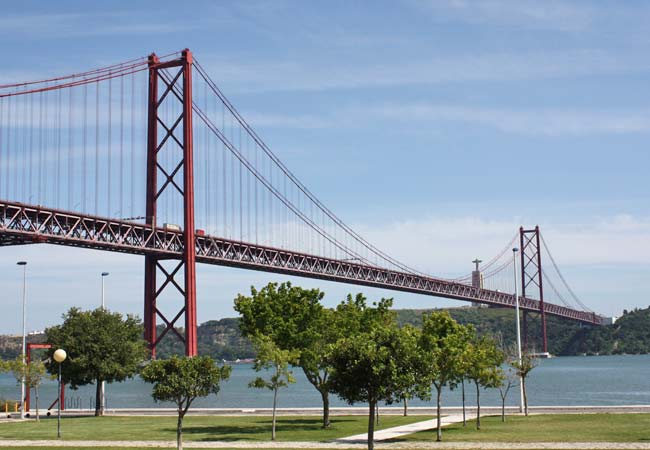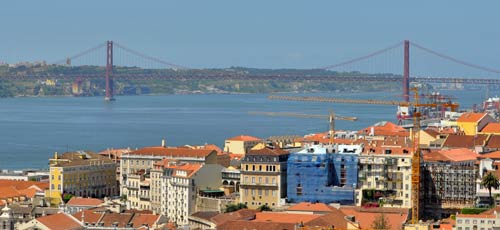LisbonLisboaPortugal.com
The best independent guide to Lisbon
LisbonLisboaPortugal.com
The best independent guide to Lisbon
Tagus River - Rio Tejo, Lisbon
Lisbon is situated on the northern banks of the River Tagus (Rio Tejo) and the slow flowing waters of the river helped create Lisbon the magnificent and vibrant city that it is today.
The river was the initial factor that established Lisbon as a significant Roman port as the estuary provided protection from the ferocious Atlantic Ocean and from this founding the city has never looked back.

The stunning Ponte 25 de Abril in Lisbon
Tagus River Why important to Lisbon?
The 14th century heralded in the the Age of Discover that was regarded as the golden age of Portugal.
These expeditions originated from the docks that ran the length of western Lisbon and once the colonies were established the wealth of the new lands poured back into Lisbon to fund the extravagance of the era.
The Portuguese as a nation are emigrants with communities dotted throughout the world and this characteristic can be traced back to the close connection with the seas and the rivers of which the Tejo is the most important.
Rio Tejo Route and Information
The River Tagus flows into the Lisbon region from the north of Portugal and opens into a wide but shallow estuary that boarders Lisbon to the east.
The estuary flows out into the Atlantic Ocean in a westerly direction between the high cliff headlands on the south bank and the flatter slopes of the capital. Click here to read a tourist guide about Lisbon ferries and cruises.

TheRio Tejo as it passes through Lisbon
At the narrowest point of the mouth of the Tagus estuary the Ponte de 25th Abril suspension bridge connects the capital with the southern commuter distracts of Almada.
This bottle neck traveling south was alleviated by the Vasco da Gama Bridge which stretches out from eastern Lisbon for 17km to the western bank of the Rio Tejo estuary.
The Tagus River originates from central Spain (the Serra de Albarracín) and cuts a generally westerly course for 716 km (445 miles) until the Portuguese boarder.
The Tagus slows significantly close to the boarder and meanders southwards forming the frontier between Spain and Portugal for 47 km (29 miles). The final 275 km (171 miles) is within Portugal where it provides a constant water supply for farm irrigation to the otherwise arid Alentejo region.

The Tagus River as it flows past the Alfama district of Lisbon
The total length of the Rio Tejo is 1,038 km (645 miles) and is the third longest river on the Iberian Peninsula behind Douro and the Ebro Rivers but the Tejo drains the second largest basin of the peninsula at 80,100 square kilometres (30,927 square miles). The Tagus estuary and Rio Tejo provide visitors to Lisbon a fantastic way to view the capital.
Discover more of Lisbon with our most popular guides
If you've found our content valuable, we'd welcome your support.
The digital publishing landscape has evolved significantly. As a small independent publisher, we face growing challenges. Search engines increasingly favour paid content over organic results, while AI-generated content often reproduces original work without attribution.
To support our work, please consider bookmarking this page (press Ctrl + D) for quick access. If you find an article helpful, we'd be grateful if you'd share it with friends on social media.
For specific questions, please see our Reddit community at r/LisbonPortugalTravel.
Should you notice any outdated or incorrect information, please contact us at [email protected]
Thank you for helping us continue to provide valuable content in an increasingly challenging digital environment.
A complete list of all of our Lisbon articles
If you've found our content valuable, we'd welcome your support.
The digital publishing landscape has evolved significantly. As a small independent publisher, we face growing challenges. Search engines increasingly favour paid content over organic results, while AI-generated content often reproduces original work without attribution.
To support our work, please consider bookmarking this page (press Ctrl + D) for quick access. If you find an article helpful, we'd be grateful if you'd share it with friends on social media.
For specific questions, please see our Reddit community at r/LisbonPortugalTravel.
Should you notice any outdated or incorrect information, please contact us at [email protected]
Thank you for helping us continue to provide valuable content in an increasingly challenging digital environment.































